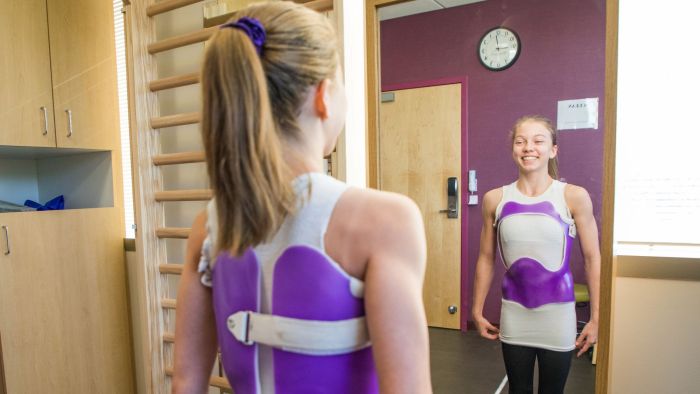Clinical scientist Michael Schwartz, PhD, and certified orthotists Kristin Smith, CO, CTO, and Brian Benish, CO, are proud to share the culmination of 14 years of hard work in validating Thoraco-Lumbo-Sacral Orthoses (TLSOs) as a treatment option with predictable outcomes for children who have idiopathic scoliosis.
Usually worn full-time or a minimum of 18 hours per day, a TLSO is considered the “gold standard” for stopping or slowing curve progression and preventing spine surgery as long as it’s worn as prescribed. Now, thanks to Dr. Schwartz, Smith, and Benish’s dedication and expertise, clinicians and their patient families can easily see how wear time — the amount of time a patient wears their brace — affects their curve progression, and therefore, their risk for needing a spine surgery in the future.
“We already knew from the landmark BRAIST study that a TLSO can be effective in managing a scoliosis curve,” Smith explains, “But what no one has really quantified until now is how much benefit a child would get per hour of TLSO wearing while taking into account their age, skeletal maturity, or initial angle of their curve."
Thermochrons Measure Brace Adherence
The first, most critical step of this yearslong endeavor was making sure that the thermochrons were delivering data that could be accurately and precisely applied to a patient’s TLSO wear time.
The team had to think about how the temperature of the brace can fluctuate even if it’s not being worn. For example, maybe on the body the thermochron logs a certain temperature, but when you throw the brace in the trunk of the car or leave it on the side of the tennis court, environmental factors can allow for higher temperatures to log too.
To combat this tricky problem, the team developed a small study where eight participants kept detailed diaries of their TLSO wear time to compare to the thermochron data points and come up with an acceptable range of temperature fluctuation. This data validation was published in Spine journal in 2012.
“There are lots of wrong ways to slap a thermometer on a device for research,” Dr. Schwartz jokes. “Without this critical validation stage and a robust algorithm, we wouldn’t be able to say our data means what we say it means — it would be entirely conjecture.”
Turning Temperature Data Into Predictive Technology
The thermochrons logged temperature data in 15-minute intervals 24/7 for 200 participants being treated for idiopathic scoliosis at Gillette Children’s and Twin Cities Spine Center. Enrollment began back in 2010.
Smith says, “It sounds like a long time, but studying outcomes in scoliosis just takes a long time. We enrolled patients for five years, the TLSO treatment for each child can take another few years, and then we wanted to follow them for two more years after that to make sure we were getting an accurate snapshot of their treatment outcomes, including their ending curve angle and any surgeries that were still necessary.”
“Involving the second center was important to us as researchers because it shows that our results are significant across different orthotists and with different TLSOs, not just specific to the Gillette Orthotics team,” adds Dr. Schwartz.
With the data set, the study team was able to create an algorithm that produces a dynamic graph of an individual’s risk of surgery that changes as their wear time changes. “The app allows a family or a provider to select a child’s initial curve and their skeletal maturity, then toggle the hours of wear time to see how different brace adherence would change their individual outcome,” Dr. Schwartz explains.
The app is a huge boon for clinicians and families alike, allowing both to look at evidence-based outcomes based on the patient’s individual situation. For example, an adolescent who is skeletally immature with a 30-degree curve could see that 18 hours of wear time lowers their surgery risk significantly as compared to 12 hours per day. It empowers individuals and families to make informed decisions on their treatment plans.
The Future of Wear Time Research
Schwartz and Smith are excited about the prospect of additional avenues of research for TLSO wear time. The team already looked at more factors that could predict risk based on their current data, like apex of the curve and curve pattern, but did not find any significant correlation.
“The next step could be to look at the brace itself,” Smith says. “By researching how the braces are built or how much correction is in the brace, clinicians would be able to inch toward optimal treatment recommendations.”
Join Our Partners in Care Community!
Subscribe to Partners in Care Journal, a newsletter for medical professionals.
Subscribe Today Home Page
Home Page

